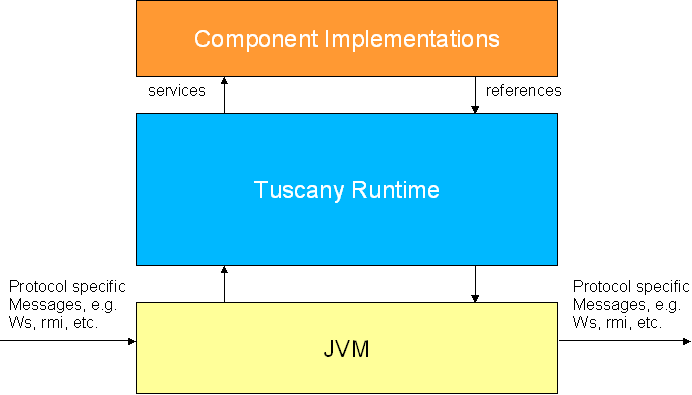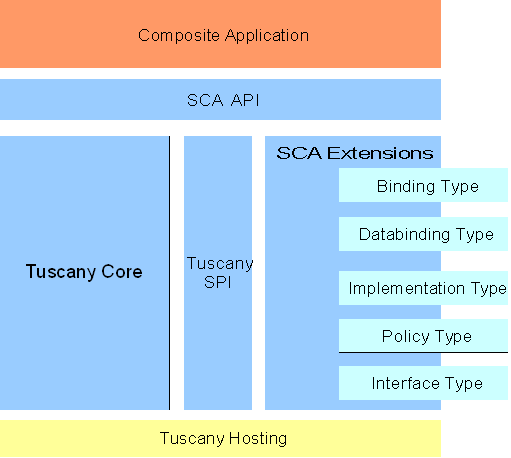Software Organization
Source Code Locations
If you take a Tuscany SCA Java source distribution or look in the Tuscany subversion repository (http://svn.apache.org/repos/asf/tuscany/java/sca/) you'll see the code layed out as follows:
BUILDING CHANGES LICENSE NOTICE README RELEASE_NOTES archetypes - Maven archetypes for creating Tuscany project templates distribution - the code that defines and build Tuscany distributions features - Maven projects that collect together Tuscany features itest - project integration tests modules - the source code for the runtime and the SCA extensions pom.xml samples - project samples shades - TBD
There is some related source code that's worth mentioning up front. Firstly the project Maven build relies on a set of Maven plugins that have been written specifically for Tuscany. They can also be found in the Tuscany subversion repository (http://svn.apache.org/repos/asf/tuscany/maven-plugins/trunk/) and are as follows:
maven-bundle-plugin - Creates Tuscany OSGi bundles based on the Tuscany modules and their dependencies
also generates eclipse PDE projects for Tuscany modules
maven-eclipse-compiler - Compiles using the Eclipse compiler and performs OSGi validation
maven-java2wsdl-plugin - TBD
maven-osgi-junit - Runs Junit tests in an OSGi environment
maven-tuscany-plugin - TBD
maven-wsdl2java-plugin - TBD
Secondly there are a set of tests that the OASIS SCA specifications define called otests. These test the Tuscany SCA runtime for compliance with the specifications. The tests themselves are stored in the OASIS subversion system (http://tools.oasis-open.org/version-control/browse/). Tuscany has a set of modules that retrieve these tests automatically and configure the Tuscany environment to run them (http://svn.apache.org/repos/asf/tuscany/otest/) as follows:
README build.xml - Ant utility script pom.xml sca-assembly - Generated automatically by svn externals when you check this directory out sca-java-caa - Generated automatically by svn externals when you check this directory out sca-java-ci - Generated automatically by svn externals when you check this directory out sca-policy - Generated automatically by svn externals when you check this directory out tuscany-java-caa-test-runner - Java Common Annotations and APIs test runner tuscany-java-ci-test-runner - Java Component Implementation test runner tuscany-policy-test-runner - Policy test runner tuscany-test-runner - Assembly test runner
SCA Java Modules
All of the functional code in Tuscany Java SCA can be found under the modules directory. There are a lot of sub-directories here but they basically fall into one of two categories, core function or extensions. We are using the term extension here in the sense that the SCA Assembly specification talks about and extension model You always have to have the core functions but most of the extensions are optional (we say most here because without some of the basic extensions the runtime won't do anything) Finding extension modules is easy. Modules that start with the following words are extensions.
binding
databinding
implementation
interface
policy
As you can see SCA extensions relate to the extensible parts of the SCA composite file. For example, if you want to use <binding.jms/> in you SCA composite files then you need to include the Tuscany modules for this extension in you installation. In this case that would mean the modules binding-jms and binding-jms-runtime.
All of the other modules in the modules directory are core modules and are generally required to be present in you Tuscany runtime installation. The use of the word "generally" here sounds a bit vague. This is because the Tuscany runtime itself is based on an extensibility mechanism which means that many parts of the runtime (as well as the SCA extensions) are pluggable. In this way, for example, different hosting environments can be supported. Well talk about runtime extensibility further down this article but for the time being consider all core modules to be mandatory.
Runtime Building Blocks
As you may have realized the Tuscany SCA Java runtime is just a Java program that, once started listens for incoming messages (via SCA component services) and, sometimes responds with outgoing messages (via SCA component references).

The runtime then provides the context within which SCA composite applications run. If we crack open the Tuscany Runtime box we see the following structure.

We'll take a high level look at these different blocks in turn starting with Core.
Tuscany Core
OSGi and JSE
The Tuscany runtime will work in the JSE environment and when deployed to an OSGi runtime like Felix or Equinox. Since 1.x we have been through an exercise of refactoring all of the runtime modules in OSGi bundles and providing consistent OSGi manifest files. See (???) for more details on how we OSGi-igfied the Tuscany runtime.